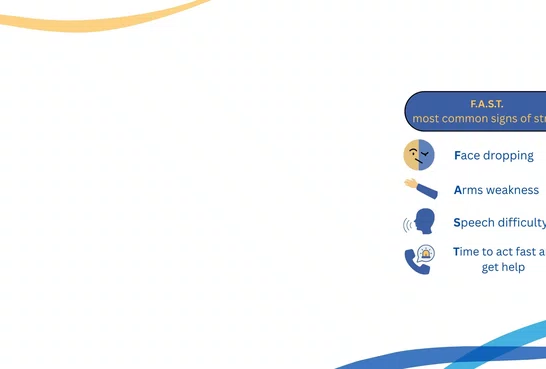
World Stroke Day is held every year on 29 October to raise awareness of stroke, its warning signs, and how it can be prevented.
The annual event was established by the World Stroke Organization (WSO), which works globally to improve stroke prevention, treatment, and support for survivors.
This year’s campaign focuses on a powerful message: Every Minute Counts. Acting fast when a stroke happens can make all the difference to survival and recovery.
What is a stroke?
A stroke is a serious medical emergency that happens when the blood flow to a part of the brain is interrupted. This can mainly happen when an artery is blocked by a clot, known as an ischaemic stroke or when an artery bursts and causes bleeding in the brain, known as a haemorrhagic stroke. You can read more about the types of strokes here .
Because the brain depends on a constant supply of oxygen-rich blood, time really is brain, and the faster treatment begins, the better the chances of recovery.
Why World Stroke Day matters
According to the World Stroke Organization, one in four people, over the age of 25, will have a stroke in their lifetime. The key to saving lives is recognising the signs early and getting emergency help quickly.
The campaign encourages everyone to learn and share the FAST acronym, a simple way to remember the most common signs of stroke:
Did you know?
While the FAST signs apply to everyone, recent research shows that stroke symptoms can sometimes look different in women.
Women are more likely to experience additional or less typical signs such as:
Because these symptoms are less recognisable, strokes in women can sometimes be misinterpreted or diagnosed later. Understanding that stroke symptoms can vary helps ensure everyone gets the right help quickly. Whether the signs are typical or not, the message remains the same: act fast and call emergency services immediately.
Become a Stroke Spotter
This year’s campaign also invites people to take part in the Spot Stroke challenge, an interactive way to test your knowledge and learn how to act fast if someone around you shows symptoms of a stroke.
You can find short awareness videos, quizzes, and downloadable resources in multiple languages on the World Stroke Organisation website, as well as additional information from organisations like the Stroke Association Uk and the American Stroke Association.
Prevention and awareness go hand in hand
While quick action is vital when a stroke occurs, prevention is just as important.
Simple lifestyle choices such as maintaining healthy blood pressure, staying active, eating a balanced diet, and avoiding smoking can significantly lower the risk of stroke.
How to get involved
You can join the campaign by:
Together we can make a difference
World Stroke Day is a reminder that awareness saves lives. By learning the signs, acting fast, and sharing the message, we can all help make sure that more people get the care they need when #EveryMinuteCounts
References:
7 things to know about how stroke is different for women
Sex Differences in Presentation of Stroke: A Systematic Review and Meta-Analysis
Stroke in Women: A Review Focused on Epidemiology, Risk Factors, and Outcomes